![]()
![]()
![]()
Use LEFT and RIGHT arrow keys to navigate between flashcards;
Use UP and DOWN arrow keys to flip the card;
H to show hint;
A reads text to speech;
64 Cards in this Set
- Front
- Back
- 3rd side (hint)
|
What is the axial skeleton? What are the 3 divisions? |
The middle/trunk of the skeleton. 1. Skull 2. Vertebral column 3. Thoracic cage (ribs + sternum) |
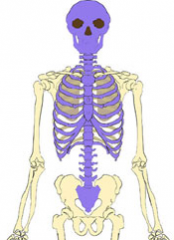
|
|
|
What is the role of the axial skeleton? (2)
|
1. Supports & protects organs in the body cavities 2. Attaches to muscles of the head/neck/trunk, respiratory system & APENDICULAR skeleton |
|
|
|
Which 4 hormones influence bone growth? (Inc their effect) |
1. Growth hormone. Stimulates bone growth in infancy + teens. 2. Thyroid hormone. Enhances the effects of GH. 3. Oestrogen. Rapid bone growth, then epiphyseal plate closure. 4. Testosterone. Lasts longer than Oestrogen. Same effect though. |
|
|
|
1. What is released from where when there is high calcium levels in the blood? 2. What does it do to the cells of the bone? 3. What is its effect outside of the bone? |
1. Calcitonin (from Thyroid) 2. Osteoblasts build more. Osteoclasts reduce activity. 2. Lower blood Ca2, less Ca2 retention in kidneys, less gut absorption of ca2 |

|
|
|
1. What is released from where with blood ca2 is too low? 2. What does it do to the cells of the bone? 3. What is the effect outside of the bone? |
1. Parathyroid hormone from PT gland 2. Osteoclast activity increase, osteoblast activity decrease 3. More cA2 retention in kidneys. More gut reabsorption. |

|
|
|
What is the appendicular skeleton? |
Everything outside of the axial skeleton, so appendages + bones + cartilage that support appendages |

|
|
|
What is synovial fluid (where is it secreted)? & What is it for? |
Slippery, viscous fluid which is secreted by the synovial membrane for: lubrication of the joint & nourishment & waste removal |
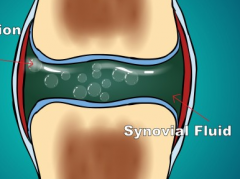
|
|
|
What is the name of the membrane around long bones? |
Periostenum |
|
|
|
What is the shaft of the bone called in long bones? |
Diaphysis |
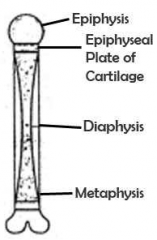
|
|
|
What is the top (on either end) of the long bone called? What is the type of bone within, and what is it covered by? |
Epiphysis Spongey bone covered by compact bone (for articulation w/ other bones) |
|
|
|
What is the lining within the bone called? |
Endosteum |
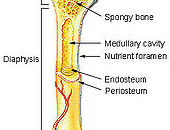
|
|
|
What is deep inside the long bone? |
Bone Marrow |
|
|
|
What is the diaphysis made of? |
Heavy wall of compact/dense bone |
|
|
|
What is the central space of the bone called? |
The medullary cavity |
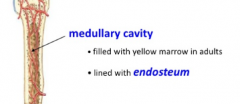
|
|
|
What is is called where the epiphysis and diaphysis meet? |
Metaphysis |

|
|
|
1. What is the membrane covering the bone called? 2. What is it made of? 3. What is it an entry/exit for? 4. What is its role? |
1. Periosteum 2. Epithelia tissue, fibrous + cellular layer 3. Blood supply + nerves 4. Protects bones, assists w/ fracture repair (blood), assists w/ thickening of bone (appositional growth) |
|
|
|
What does the thoracic cage consist of? (3) What is its roles? (3) |
Thoracic vertebra Ribs Sternum Attachment site for upper limbs Protects organs Expands during ventilation |
|
|
|
What are the two types of ribs? (kind of 3) |
"True" ribs (attached to sternum via hyaline cartilage) 1-7 "Flase" ribs 8-12 + also floating ribs |
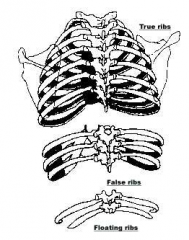
|
|
|
What is isometric contraction in muscle movement? |
Muscle length and joint angle the same but muscles contract e.g. holding a glass of water being filled up! |
isometric = M = more weight |
|
|
What is isotonic contraction in muscle movement? |
Muscle length changes but without additional tension - tension remains constant e.g. bicep curl. tension builds even before you lift it. |
Tonic = tone |
|
|
What type of tissue is bone? |
Connective tissue. |
|
|
|
What are the two types of bone marrow? |
Red: produces red blood cells and white blood cells Yellow: fat and mineral storage |
|
|
|
What are the (6) types of bones? / bone classifications |
Long Bones Short Flat Bones Irregular bones Sutural Bones Sesamoid bones |
|
|
|
Where are long bones found? |
The limbs. Femur, humerus |
|
|
|
Where are flat bones found? What are their characteristics? |
Sternum, ribs, scapulae Thin, roughly parallel |
|
|
|
Where are sutural bones found? What is their nature? |
Skull Irregular shaped, like "stitches" |
|
|
|
Where are irregular bones found? What is their nature? |
Vertebra, pelvis Short, flat, notched. Don't fit any other class, hence irregular |
|
|
|
Where are short bones found? |
Small, boxy e.g. carpals, tarsals |
carpals: hand tarsals: foot |
|
|
Where are sesamoid bones found? Their nature? |
Within tendons, small e.g patella, small bones in foot |
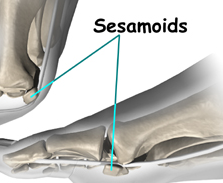
|
|
|
What are the functions of the skeletal system? (6) |
1. Support 2. Storage of minerals, lipids, ions 3. Blood cell production 4. Protection of soft tissues 5. Leverage for muscles 6. Acid-base homeo: absorbing & releasing alkaline salts |
|
|
|
What are the (4) types of bone cells? |
1. Osteoclasts 2. Osteoblasts 3. Osteocytes 4. Osteoprogenitor cells |
|
|
|
What do osteoprogenitor cells do? |
They are the stem cells that give rise to osteablasts They also assist in small repairs |
|
|
|
What do Osteoblasts do? |
Build bone ("B") They deposit minerals 2 form new bone |
|
|
|
What do Osteoclasts do? |
They dissolve bone matrix (opposite of the blasts) |
|
|
|
What do Osteocytes do? |
They're matured osteoblasts They maintain the matrix by continually dissolving + depositing new matrix |
|
|
|
What is Wolfe's law? |
Bone is laid where it is needed and removed from where it is not |
|
|
|
What is the role of "bone remodelling"? (4) |
- Repair micro-fractures - Release minerals into blood - Accumulate minerals for storage - Reshape bones in response to use (or not) |
|
|
|
Which cells are involved in "bone remodelling"? (2) |
- Osteoblasts - Osteoclasts |
|
|
|
What are the steps of endochondrial ossification? (5) Essentially this is bone growth + development in neonates |
1.Chondrocytes @ centre of cartilage enlarge & then die. Matrix calcifies. 2. New OB cover shaft with a thin layer of bone 3. Blood vessels penetrate & new OB form growth centre 4. Bone of shaft thickens & epiphysis forms 5. Blood vessels invade epip, form 2ndary ossification sites |
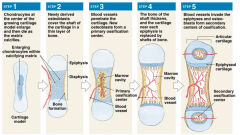
|
|
|
What are the two types of bone there can be? Their roles? |
1. Compact bone. Heavy. Strong. Structure and support. 2. Spongey bone. Light. Marrow. Stress distribution. |
|
|
|
What are the (4) steps of bone elongation? |
1. Diaphysis side of epiphyseal plate: OB convert cartilage into bone. 2. Epiphysis constantly making new cartilage. 3. Continued elongation until cartilage growth slows + bone conversion accelerates 4. Epiphyseal seal closes when bone catches up to cartilage |
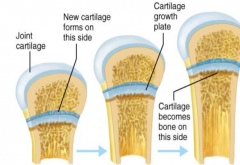
|
|
|
How many joints in the body are Synovial? What is the def of synovial joint? |
95% 2 adjacent bones separated by a fibrous joint capsule filled w/ synovial fluid |
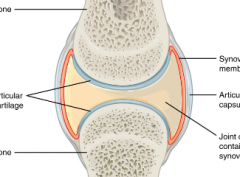
|
|
|
What does hyaline cartilage provide b/w the articulating surfaces of a synovial joint? (3) |
- Protection - Weight distribution - shock absorb |
|
|
|
What are the (6) types of synovial joints? |
- Ball and socket - Condyloid - Saddle - Gliding - Hinge - Pivot |
|
|
|
What is an e.g. of a ball and socket joint? what type of joint is this? |
Hip, shoulder Synovial |
|
|
|
What is an e.g. of a condyloid joint? What type of joint is this? |
Wrist, ankle Synovial |

|
|
|
What is an e.g. of a saddle joint?What type of joint is this? |
Base of thumb Synovial |
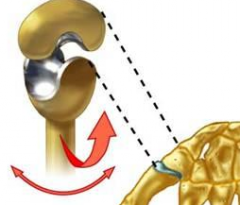
|
|
|
What is an e.g. of a gliding joint?What type of joint is this? |
Carpals & tarsals Synovial |
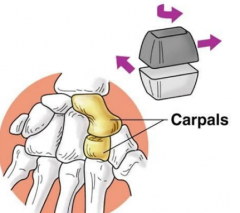
|
|
|
What is an e.g. of a hinge joint?What type of joint is this? |
Elbows, knees Synovial |
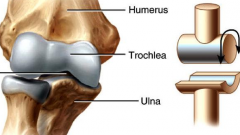
|
|
|
What is an e.g. of a pivot joint?What type of joint is this? |
Neck / b/w vertebrae Synovial |

|
|
|
What are the 2 elements of the bone matrix? What are their roles? |
2/3 Minerals: resist compression, hard. 1/3 Proteins: collagen. resist tension. flexible. |
|
|
|
What are the (4) classes of joints in the body? |
Synovial / no movement Bony / no movement Cartilaginous / little movement Fibrous / free movement |
|
|
|
What is an example of a "bony joint"? |
The skull The epiphysis & diaphysis of long bones - it is a joint that is formed when the gap b/w two bones ossify |
|
|
|
What does the structure of a flat bone resemble? |
A sandwich (of spongey bone b/w two layers of compact bone) |
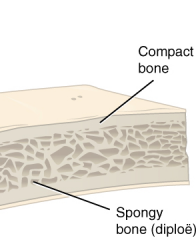
|
|
|
What are fibrous joints characterised by? |
Being adjacent bones bound by collagen fibres AKA sutures in the skull of an infant Teet |
|
|
|
What are cartilaginous joints? E.g.? |
2 bones linked together by cartilage AKA public symphysis |
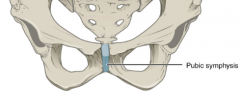
|
|
|
What properties does protein bring to a bone? |
Flexibility |
|
|
|
What properties does calcium phosphate bring to the bone? |
make it withstand compression very hard / bone strength |
|
|
|
What happens when a bone has no collagen? |
Brittle bones |
|
|
|
What happens when the calcium salts are taken from a bone? |
Very bend and flexible |
|
|
|
What does synarthrosis mean? |
No movement joint aka skull sutures of that fibrous joint |
|
|
|
What does amphiarthosis mean? |
Little movement aka pelvis / public symphysis |
|
|
|
What does symphysis mean? |
Type of cartilaginous joint. Fusion b/w bones with fibrocartilage |
|
|
|
What does diarthrosis mean? |
Free movement AKA synovial joints of shoulder or elbow |
|

